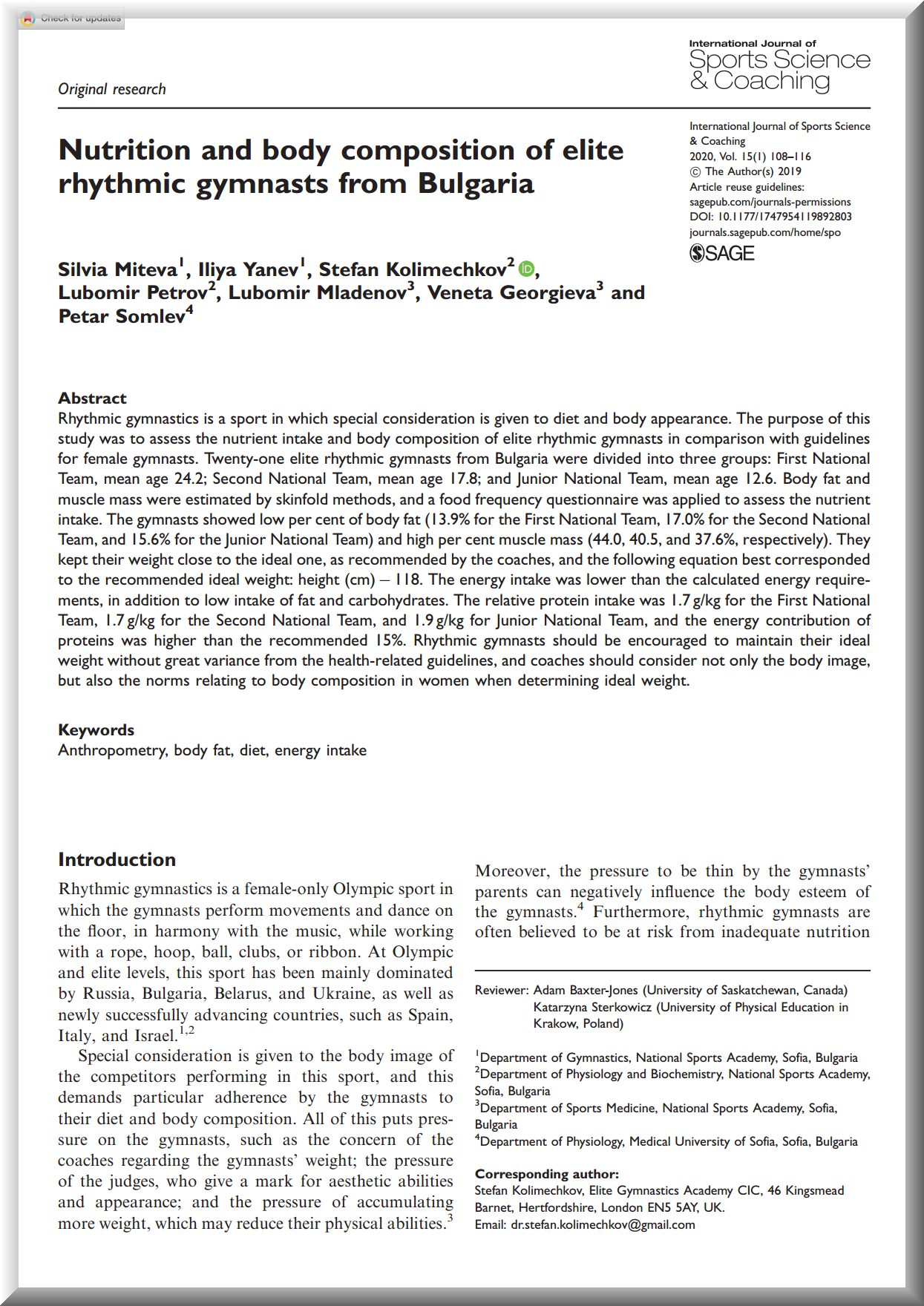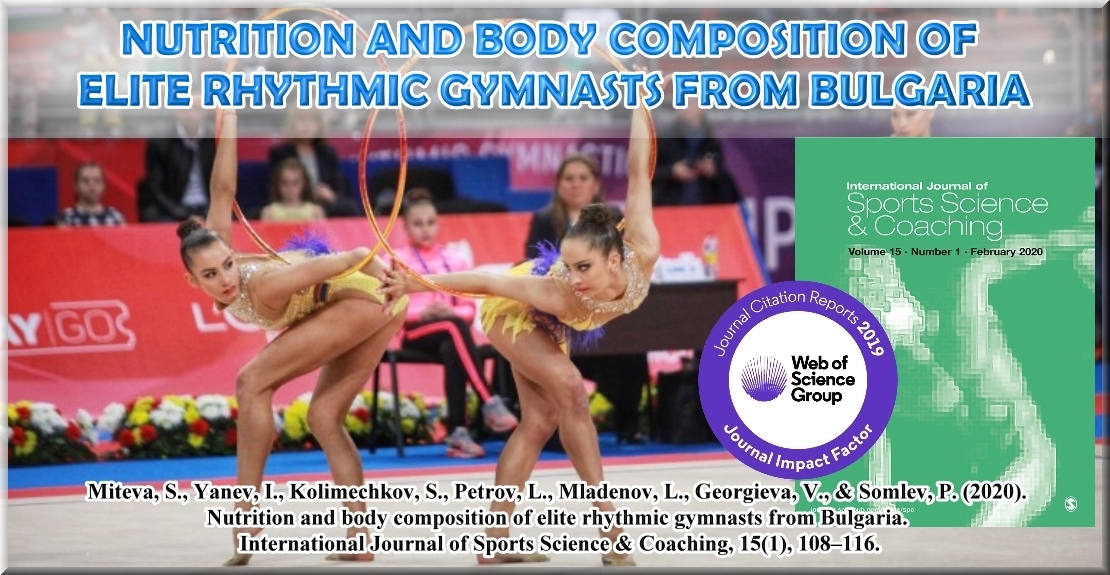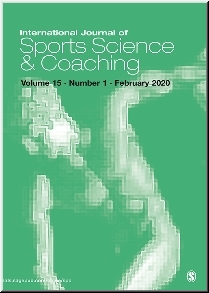Nutrition and body composition of elite rhythmic gymnasts from Bulgaria

Silvia Miteva, Iliya Yanev, Stefan Kolimechkov, Lubomir Petrov, Lubomir Mladenov, Veneta Georgieva, Petar Somlev
How to cite:
Miteva, S., Yanev, I., Kolimechkov, S., Petrov, L., Mladenov, L., Georgieva, V., & Somlev, P. (2020). Nutrition and body composition of elite rhythmic gymnasts from Bulgaria. International Journal of Sports Science & Coaching, 15(1), 108–116. https://doi.org/10.1177/1747954119892803
IMPACT FACTOR: 1.253
International Journal of Sports Science & Coaching

 United Kingdom, published by SAGE Publications Ltd
United Kingdom, published by SAGE Publications Ltd
ISSN:1747-9541 / eISSN: 2048-397X | website: www.journals.sagepub.com/home/spo
ABOUT THE JOURNAL
The International Journal of Sports Science & Coaching is an international, peer-reviewed, impact factor journal, which aims to bridge the gap between coaching and sports science. The journal integrates theory and practice in sports science, promotes critical reflection of coaching practice, and evaluates commonly accepted beliefs about coaching effectiveness and performance enhancement. This journal has an impact factor of 1.3, and it is indexed in the international database Clarivate Analytics: Science Citation Index Expanded (Web of Science), SCOPUS and other databases.
ABOUT THIS ARTICLE
This study was on nutrition and body composition of elite rhythmic gymnasts, and included a unique sample of world-class competitors (21 elite rhythmic gymnasts between the ages of 12 and 27 from the Bulgarian national team). The first group in our sample were the 2016 Olympic bronze medallists, and gold medallists at the 2014 World Championship. The second group were the 2017 World Silver Medallists and 2018 World Gold Medallists in rhythmic gymnastics. I presented the main results of the study at the biggest conference in sports science in Europe, the ECSS Congress in 2019. The results showed that the nutrient intake in the groups correspond to the guidelines for female gymnasts; however, coaches should focus on individual competitors who show values below the recommended guidelines.
Nutrition and body composition of elite rhythmic gymnasts from Bulgaria
Published Journal Article

International Journal of Sports Science & Coaching
Vol. 15, Issue 1, February 2020, pp. 108–116
NUTRITION AND BODY COMPOSITION OF ELITE RHYTHMIC GYMNASTS FROM BULGARIA
Silvia Miteva, Iliya Yanev, Stefan Kolimechkov, Lubomir Petrov, Lubomir Mladenov, Veneta Georgieva, Petar Somlev
National Sports Academy, Sofia, Bulgaria
ABSTRACT
Rhythmic gymnastics is a sport in which special consideration is given to diet and body appearance. The purpose of this study was to assess the nutrient intake and body composition of elite rhythmic gymnasts in comparison with guidelines for female gymnasts. Twenty-one elite rhythmic gymnasts from Bulgaria were divided into three groups: FNT (First National Team, mean age 24.2), SNT (Second National Team, mean age 17.8), and JNT (Junior National Team, mean age 12.6). Body fat and muscle mass were estimated by skinfold methods, and a food frequency questionnaire was applied to assess the nutrient intake. The gymnasts showed low %BF (13.9% for the FNT, 17.0% for the SNT, and 15.6% for the JNT), and high percent muscle mass (44.0%, 40.5% and 37.6%, respectively). They kept their weight close to the ideal one, as recommended by the coaches, and the following equation best corresponded to the recommended ideal weight: height (cm) – 118. The energy intake was lower than the calculated energy requirements, in addition to low intake of fat and carbohydrates. The relative protein intake was 1.7 g/kg for the FNT, 1.7 g/kg for the SNT, and 1.9 g/kg for JNT, and the energy contribution of proteins was higher than the recommended 15%. Rhythmic gymnasts should be encouraged to maintain their ideal weight without great variance from the health-related guidelines, and coaches should consider not only the body image, but also the norms relating to body composition in women when determining ideal weight.
Keywords: Anthropometry, body fat, diet, energy intake.
Full Text: Nutrition and body composition of elite rhythmic gymnasts from Bulgaria. International Journal of Sports Science & Coaching
This article is published in an impact factor journal without open access!
Available on the official website of the Journal
Abstract is also available on ResearchGate
Authors
Silvia Miteva
Department of Gymnastics, National Sports Academy, Sofia, Bulgaria
Assistant Professor Iliya Yanev PhD
Department of Gymnastics, National Sports Academy, Sofia, Bulgaria
Research Gate | Google Scholar
Stefan Kolimechkov PhD
Department of Physiology and Biochemistry, National Sports Academy, Sofia, Bulgaria
Academia.edu | ORCID | Research Gate | Google Scholar
Associate Professor Dr Lubomir Petrov PhD
Department of Physiology and Biochemistry, National Sports Academy, Sofia, Bulgaria
Academia.edu | ORCID | Research Gate | Google Scholar
Assistant Professor Dr Lubomir Mladenov
Department of Sports Medicine, National Sports Academy, Sofia, Bulgaria
Veneta Georgieva
Department of Sports Medicine, National Sports Academy, Sofia, Bulgaria
Assistant Professor Dr Petar Somlev PhD
Department of Physiology, Medical University of Sofia, Sofia, Bulgaria
Corresponding author: e-mail: dr.stefan.kolimechkov@gmail.com
DOI: 10.1177/1747954119892803
How to cite this article:
Miteva, S., Yanev, I., Kolimechkov, S., Petrov, L., Mladenov, L., Georgieva, V., & Somlev, P. (2020). Nutrition and body composition of elite rhythmic gymnasts from Bulgaria. International Journal of Sports Science & Coaching, 15(1), 108–116. https://doi.org/10.1177/1747954119892803

